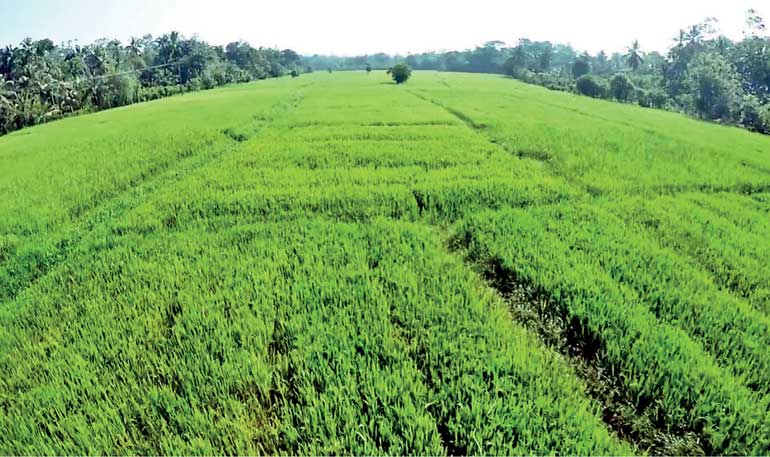Tuesday Dec 16, 2025
Tuesday Dec 16, 2025
Tuesday, 28 November 2017 00:00 - - {{hitsCtrl.values.hits}}

“Devo vasssatu kalena – sassasampatti hotu ca
phito bhavatu loko ca – raja bhavatu dhammiko”
(May rain fall in time, may crops be bountiful,
may the people be prosperous, and
may the rulers be righteous)
The reality of climate change is here, and you don’t need to read another learned scientific paper to realise it. All you need to do is open your window and realise that the weather patterns are very different from what they used to be with droughts and floods becoming more severe.
Traditional outdoor agriculture can no longer be relied upon to feed us in this world of climate change. If the rulers decide to proceed with the proposed idea, then the crops will indeed become bountiful and the people prosperous, without any reliance on rainfall.
Controlled environment farming
Many countries have invested in Controlled Environment Farming (CEF)—sometimes referred to as indoor or vertical farming—due to the many benefits it provides.
nCEF aims to make the best use of available natural, human and capital resources; the controlled environment helps maintain optimum levels of water, nutrients, temperature and humidity for year-round crop production.
 Widespread adoption of CEFs has not happened due to the high capital cost and energy demands of running them. However, many countries are combining CEFs with renewable energy sources to make them operationally more viable while gaining the many benefits mentioned above.
Widespread adoption of CEFs has not happened due to the high capital cost and energy demands of running them. However, many countries are combining CEFs with renewable energy sources to make them operationally more viable while gaining the many benefits mentioned above.
Sundrop Farms1 is an illustrative example of a $ 150 m investment that produces 15% of Australia’s tomatoes using only sea water and sunlight. However, as climate change begins to affect the sustainability of traditional outdoor agriculture, then CEFs offer a viable alternative to ensure our food security.
Given the climate change effects that have already negatively impacted our outdoor agriculture, it is best for Sri Lanka to start a crash program for CEFs, and the capital required to build those CEFs is in the gold available to us in our paddy lands.
‘Gold’ in our paddy lands
Sri Lanka has approximately two million acres designated as paddy lands2 and these lands cannot be used for any other purposes than growing rice per the Paddy Lands Act of 1958. The Government of Sri Lanka has proposed in the 2018 Budget that paddy lands can be used for other agricultural purposes to grow more profitable crops, potentially even for export. This is to be lauded. But it should go further by allowing paddy land use for purposes other than growing crops.
Population growth, urban sprawl, and expressways have created high demand for residential and commercial use lands which can readily be met by converting a portion of our paddy lands in those high demand areas. Buildable land in rural areas command prices of Rs. 1 lakh per perch or higher when compared to the typical valuation of Rs. 5,000 per perch for paddy lands.
If 20% of paddy lands were allowed to be converted to buildable lands which can be sold by the owners for Rs. 100,000/perch on average, the value of those sales would amount to Rs. 6,400 billion or approximately $ 42 billion. For reference, Sri Lanka’s GDP currently is at $ 81 billion, and some portion of the money in the hands of the owners will result in the starting of enterprises which will contribute to additional goods and services to benefit our GDP. Even if only 10% of the money went into starting enterprises, this “Domestic Direct Investment” would be far greater than any plans of the Government to attract FDI.
The stamp duty paid by the buyer to the Government would be $ 1.68 billion, and if a tax of 10% was levied on the seller rather than the more complicated 10% capital gains tax, then another addition $ 4.2 b in taxes would be available for a total of $ 5.88 billion. Rather than squandering this tax boon on more luxury cars and other perks for MPs and Local Government politicians, it is proposed that the money be loaned to individuals and companies who want to start CEFs with renewable energy supplies. These long grace period, low interest, Government-guaranteed loans will result in many benefits.
The benefits
The many benefits to Sri Lanka are:
Factors to consider
Building on paddy lands should not be done haphazardly. Paddy lands perform important flooding and drainage functions within the larger hydrological landscape in which they are embedded. Hence, issues related to flooding and drainage as well as those related to usage of land and water, both upstream and downstream, should be addressed when building on converted paddy lands. Measure such as re-profiling and deepening the streams (elas) that exist next to paddy fields may be considered depending on site-specific conditions.
The Government may have to use a portion of the $ 5.88 to create this rainwater drainage system. This would be a more environmentally sensible alternative to filling the paddy lands with soil to raise their level. The easements for the drainage systems will be purchased by the Government at the paddy land valuation prices to maximise the benefit to the country.
Paddy cultivation provides poor economic yield in Sri Lanka since the two million acres are in 1.6 million parcels and is environmentally demanding because of the large quantities of water needed for cultivation. It may sound sacrilegious, but Sri Lanka and the farmers (if they insist on staying in agriculture) are far better off importing rice and using the paddy lands for growing more profitable crops, especially for export.
The primary barrier to overcoming this heresy, is the cultural tenant that the traditional paddy cultivating goviya (farmer) is a foundation of our society. The cruel reality is the paddy farmer is a hard working pauper in our society. The Government would have to mount an effective PR campaign to ensure that “traditionalists” don’t derail the attempts to convert paddy lands and start CEF based agriculture for our collective benefit.
There is a concern amongst some MPs that allowing farmers to sell their land will result in them drinking away their wealth. The reality is that the farmers are currently depressed and drinking whatever meagre income they have because of their dire economic circumstances, and even committing suicide. The few tens of millions of rupees from their land sale (average lot size is about 1.3 acres) should result in far better economic circumstances for the majority of responsible farmers.
Finally, the Department of Agrarian Services which maintains the Paddy Lands Registry, will have to be ordered by the Cabinet to implement a simple, streamlined process where any paddy land owner’s application for conversion to buildable land is approved within one week without delay and discretionary power exercising.
Conclusion
Thus, Sri Lanka can create a ‘100% organic produce’ exporter brand name for itself, and most importantly lay the foundation for our food security in the worsening climate change Armageddon.
Footnotes
1 http://www.sundropfarms.com/
2 http://www.statistics.gov.lk/agriculture/Paddy%20Statistics/PaddyStatsPages/azSriLanka1415.html#Acres
3 http://www.lankasaladcompany.com/
4 https://www.facebook.com/AiGROW/
(Tilak Dissanayake has been a product design engineer for almost 40 years, and is currently designing a drone network for middle-mile air cargo transport between main cities. Dr. Hilmy Sally is a civil engineer and water resources consultant and counts 40 years of international professional experience in nearly 30 countries in Africa, Asia and Europe. They are concerned citizens who want to see Sri Lanka and their fellow citizens prosper. They invite comments and questions and can be reached at [email protected] or [email protected].)